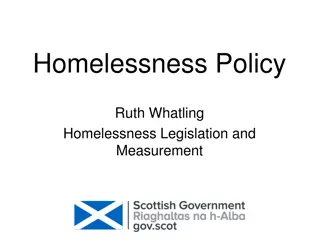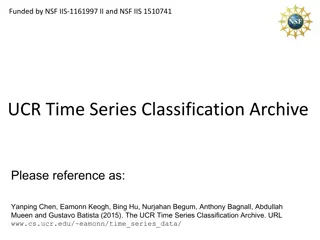
Insights from Pit Data: Mobilizing Results and Understanding Homelessness Trends
Explore the process of working with Point-in-Time data to understand homelessness trends effectively. Learn how to clean and prepare data, analyze results in simple formats, interpret small numbers, visualize data with charts and graphs, and highlight key demographics and challenges faced by the homeless population. Uncover the importance of utilizing shelter statistics and acknowledging uncounted individuals to gain a comprehensive view of homelessness statistics.
Download Presentation

Please find below an Image/Link to download the presentation.
The content on the website is provided AS IS for your information and personal use only. It may not be sold, licensed, or shared on other websites without obtaining consent from the author. If you encounter any issues during the download, it is possible that the publisher has removed the file from their server.
You are allowed to download the files provided on this website for personal or commercial use, subject to the condition that they are used lawfully. All files are the property of their respective owners.
The content on the website is provided AS IS for your information and personal use only. It may not be sold, licensed, or shared on other websites without obtaining consent from the author.
E N D
Presentation Transcript
Mobilizing Results: Working with PiT Data Aaron Segaert November 2015 Module 7 Mobilizing Results
Now that we have the data, what do we do? Clean and prepare the data Get set up for analysis There is always a possibility of data entry errors or other mistakes. As you work with the data, keep an eye out for contradictory or nonsensical results If something looks very wrong, delete the incorrect bit of information (i.e. treat it as missing information). You can still count the person and use the rest of their information
Results: Simple and to the point PiT count results are intuitive, simple and easy for people to understand: On any given night, about 200 people are homeless No complicated statistics or methods are required, mostly counts and percentages: 5.7% have Aboriginal ancestry 27% are female 14 of the 26 people surveyed on the street have not used a shelter in the past year
Small numbers Aside from Canada s largest cities, the total number of people counted will be in the hundreds or even dozens, so some categories will have very small numbers: Key Demographics N % Male Female Veteran Aboriginal Recent Immigrant/refugee Child Youth Adult Senior 139 52 5 11 5 5 37 143 7 72.4% 27.1% 2.6% 3.1% 2.6% 2.6% 19.3% 74.5% 3.6%
Use charts and graphs 25% 22.9% 19.8% 19.8% 18.8% 20% 15% 13.0% 10% 3.6% 5% 2.1% 0% 0-14 15-24 25-34 35-44 45-54 55-64 65+ Age Groups
Pregnancy 1.0% Brain injury 1.6% Learning disability 2.6% Fetal alcohol spectrum 4.2% Physical disability 8.3% Chronic/acute medical 12.5% Mental illness 20.3% Addiction or substance abuse 28.1% % of respondents
Show detailed info in tables Times homeless in past three years One 135 70.3% Two 28 14.6% Three or more 29 15.1% Fifteen percent are episodically homeless
Play to the strengths of PiT An opportunity to put shelter statistics in context: How many people are not being counted in shelter statistics? There is scant real-world data on this question 20% of respondents were sleeping in locations other than a shelter, and 53% reported not using a shelter in the past year Overall, 92.7% of those enumerated were either in a shelter on the night of the count or used a shelter at some time during the past year
Play to the strengths of PiT What are the characteristics of people who do not use shelters? Are some groups less likely to use shelters? Used a shelter in past year? Yes 91.3% 96.2% 60.0% 81.8% 91.9% 92.3% 100.0% 92.7% Demographics No Male Female Veteran Aboriginal Youth Adult Senior Total Sample 8.7% 3.8% 40.0% 18.2% 8.1% 7.7% 0.0% 7.3%
Compare and contrast Use existing community data from Statistics Canada and other sources to compare and contrast with the general population: Seniors are under-represented relative to the general population, with only 3.6% of those surveyed aged 65 or over 2.6% reported having military service, about the same as the percentage of Veterans in the wider community
Compare and contrast Look at differences between groups, e.g., those surveyed on the street vs. in shelter: Location % Male Street 83.8% Shelter 73.7% The proportion of males is higher on the street than in shelters
Dont expect big surprises It s okay if there are no earth-shattering results! The results should be interpreted with caution if they show something unexpected. After all, this is a single point in time If your community is thought to have a high rate of Aboriginal homelessness, or lots of people migrating to the community and becoming homeless, etc., the results will probably show this But you never know maybe the results will force people to reconsider their preconceptions about the homeless population






















